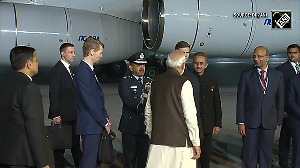The Bush administration plans to shift nearly $230 million in aid to Pakistan from counter-terrorism programmes to upgrading the country's aging F-16 attack planes, drawing flak from US lawmakers.
In a two-page notification to Congress, the State Department said that upgrading the avionics, electronics and radar systems of Pakistan's older F-16s would 'increase the survivability of the aircraft in a hostile environment' and make the 'F-16s a more valuable counter-terrorism asset that operates safely during day and night operations'.
However, the proposed upgrade of F-16s, which Pakistan prizes more for their contribution to its military rivalry with India than for fighting insurgents along its Afghan border greeted with dismay and anger by US lawmakers who may block the move, the New York Times said.
The notification said the modernised systems would also increase the accuracy of the F-16s' support of Pakistani ground troops, lessening the risks of civilian casualties.
Lawmakers and their aides were quoted as saying that F-16s do not help the counter-terrorism campaign and defy the administration's urgings that Pakistan increase pressure on Al Qaeda and Taliban fighters in its tribal areas.
The timing of the action, the paper said, also caught lawmakers off guard, prompting some of them to suspect that the deal was meant to curry favour with new Pakistani Prime Minister Yousaf Raza Gilani, who will meet with President George W Bush in Washington next week.
The debate over the F-16 financing comes at a time when Congress has grown increasingly frustrated with the administration's Pakistan policy, arguing it has been weighted too heavily on security assistance.
The US has given more than $10 billion in military aid to Pakistan since the September 11 attacks. Of that amount, $5.5 billion was specifically intended to reimburse the counterinsurgency efforts by the Pakistani Army, but Congressional auditors have said that Pakistan did not spend much of that money on counterinsurgency.
The move could also be aimed at easing tensions over the 11 members of the Pakistani paramilitary forces killed in an American air-strike along the Afghan border last month.
The financing for the F-16s, the Times said, would represent more than two-thirds of the $300 million that Pakistan will receive this year in American military financing for equipment and training.
Last year, Congress required those funds to be used specifically for law enforcement or counter-terrorism purposes.
Pakistan's military has rarely used its current fleet of F-16s, which were built in the 1980s, for close-air support of counter-terrorism missions, largely because the risks of civilian casualties would inflame anti-government sentiments in the Federally Administered Tribal Areas, the daily said.
State Department officials were said that the upgrades would greatly enhance the F-16s' ability to strike insurgents more accurately, while reducing the risk to civilians.
The officials said the timing was driven by deadlines of the American contractor, Lockheed Martin. Having the United States pay for the upgrades instead of Pakistan would also free up cash that Pakistan's government could use to help offset rising fuel and food costs in the country, which have contributed to an economic crisis there, State Department officials told the paper.
Under the original plan sent to Congress in April, the administration planned to give Pakistan up to $226.5 million of the aid to refurbish two P-3 maritime patrol planes, buy new airfield navigation aids and overhaul Pakistan's troubled fleet of Cobra helicopters.
The State Department notified Congress last week that the administration had changed its mind and would apply the funds to the F-16s, the Times reported.
Lawmakers, the paper said, immediately bridled at the shift, questioning whether the counter-terrorism money could be spent more effectively.
"We need to know if this is the best way to help Pakistan combat Al Qaeda and the Taliban," Senator Patrick J Leahy, a Democrat who heads the appropriations subcommittee on State Department and foreign operations, was quoted as saying.
Many Congressional officials, the Times says, remain unconvinced.
"Using F-16s this way is like hitting a fly with a sledgehammer," one senior Senate Democratic aide was quoted as saying. But the paper also said it remains unclear whether any lawmaker will block or postpone the financing, and risk harming relations with Pakistan any further.
Even if approved, the upgraded F-16s would not be available until 2011, said one House aide, raising the question whether the funds could be spent on counter-terrorism equipment that could be employed more quickly.
Senior administration officials, including top military officers, are also voicing increasing exasperation with Pakistan's efforts to combat militants in the mountainous region along the border with Afghanistan, the report noted.
Pakistan agreed to buy about 70 F-16s in the 1980s, and about 40 were delivered before Congress cut off all aid and military sales in 1990, citing Pakistan's secret development of nuclear weapons.
A new deal was struck after the September 11 attacks to allow Pakistan to buy newer models, in part to reward Pakistan's cooperation in fighting terrorism.
In 2006, Pakistan was a major recipient of American arms sales, including the $1.4 billion purchase of up to 36 new F-16C/D fighter aircraft and $640 million in missiles and bombs, the paper noted.
The deal included a package for $891 million in upgrades for Pakistan's older F-16s.




